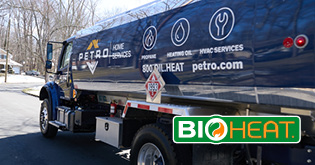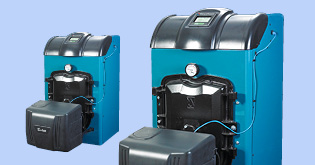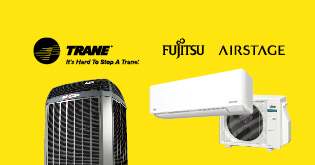- My Account:
- Sign In
- Register
- Make Payment

How long do furnaces last? When to repair or replace.
Count on Petro for guidance and help with furnace replacement services and repairs.
As one of the most important investments and pieces of equipment in your home, it pays to keep track of just how efficiently and effectively your warm air oil or natural gas furnace is running. You need to know when to replace it before it costs you more in repairs than a new purchase or if it becomes unsafe. A comfortable and healthy home environment requires an energy-efficient and safe heating system. One that heats the home without using large amounts of energy and that doesn't endanger the indoor air quality.
When is it time to consider getting a new furnace?
If your oil or natural gas furnace is 12 years old or younger, and has been properly maintained, you shouldn't need to worry about replacing your unit just yet. Instead, you should spend some time and money to improve the energy-efficiency in other areas of your home and ensure that you perform regular, proper maintenance of your furnace to keep it lasting longer.
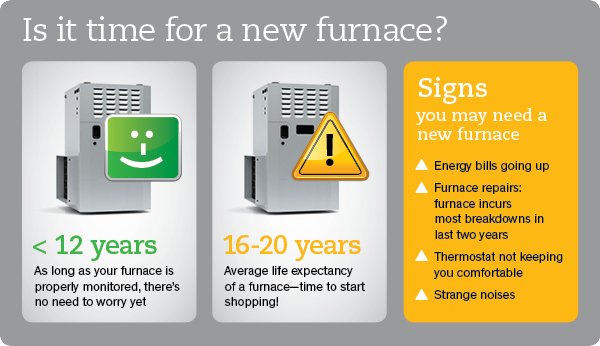
Warning signs of a failing furnace.
It is important to be aware of some warning signs from your oil or natural gas furnace that indicate it may need replacing. A cold, snowy winter night with a failing or faltering furnace is not the time to assess your heating system. It pays to be prepared and information is the key to making a wise decision. Below are some warning signs that it may be time to consider replacing your furnace. Of course, not all of them may apply to your particular equipment, but you may use them as a general rule of thumb to gauge just how much life left you have in your furnace.*
Warning signs: When you may need to replace your furnace.
1. Your furnace is 16-20 years old:
A good place to start is to compare your oil or natural gas furnace age to the national average. The average life expectancy of furnaces in homes today is between 16 and 20 years. If your furnace is close to this age or older, you should begin shopping. Shopping for a replacement furnace in an emergency does not allow time for you to make your best decision. Most people prefer to replace their furnace as a planned home improvement rather than in an emergency if it falters or has already failed.
The typical lifespan of a warm air furnace will vary based on its operating environment, that's why it's important to have the system serviced regularly by a qualified technician. They will be able to properly assess the condition of the furnace and make any recommendations.
Repair: If your furnace system is less than 15 years old.
Replace: If your furnace system is over 15 years old.
2. Your energy bills are going up
Rising energy costs are not the only reason for high bills. Furnaces often lose their efficiency as they age, especially if they have not been properly maintained. As a result, your oil or natural gas furnace may run longer to provide the same amount of heat. This will cause your energy bills to go up. Your monthly energy payments could contribute towards a new, more energy-efficient furnace, reducing your bills and increasing energy savings over time. Start to compare the cost of your recent heating bills with heating bills from the previous years. If there is a significant difference, then it’s time to replace your furnace.
Repair: If your furnace system is less than 15 years old and the cost of repair is less than half the cost of replacement.
Replace: If your furnace system is more than 15 years old and requires a costly repair to maintain efficiency.
3. You have had multiple furnace repairs in the past two years.
Furnaces are like cars. As they age, furnaces need to be repaired more frequently. You can replace one part and then need another part replaced or repaired next year. It doesn't take long to spend $500 just to keep an old oil or natural gas furnace running. Furnaces incur the most breakdowns in the last 2 years of their lives. As a furnace ages, it gets harder to source replacement parts. Waiting can be really cold on a below-zero night.
4. Rooms are an inconsistent temperature.
Do you feel that some rooms are too cold while others are too hot? Or are you always trying to adjust your thermostat to make your home more comfortable? This is a sign that your furnace lacks the ability to properly distribute the air to keep you comfortable in your home.
5. Your furnace is producing carbon monoxide.
All heating systems run the risk of carbon monoxide emissions. However, owners of older chimney-vented oil-fired furnaces don't necessarily face the same safety concerns posed by natural gas and propane, since oil-fired boilers and forced-air furnaces tend to be much less likely to produce carbon monoxide. Because they were built like tanks and require regular annual maintenance and cleaning by a qualified service technician, many of these units work safely and reliably for decades.
If you do have a natural gas or propane furnace, a yellow or flickering flame may be a sign that poisonous carbon monoxide could be created by your furnace. Other possible signs of carbon monoxide are:
- Streaks of soot around furnace
- Absence of an upward draft in your chimney
- Excess moisture found on windows, walls, or other cold surfaces
- Excessive rusting on flue pipes, other pipe connections, or appliance jacks
- Small amounts of water leaking from the base of the chimney, vent, or flue pipe
- Rust on the portion of the vent pipe visible from the outside
Always be mindful and monitor your furnace for any of the signs noted above and always make sure to have carbon monoxide detectors on every floor of your home, particularly close to your furnace room.
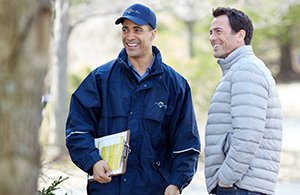
6. Your furnace has cracks in the heat exchanger.
As they age, furnaces can run the risk of developing cracks in the heat exchanger. Carbon monoxide, if present, could leak into your home undetected. Cracks in the heat exchanger can occur undetected which is why no one advises waiting until they occur. If your family is potentially being exposed to carbon monoxide, the furnace needs to be replaced immediately.
7. Your furnace is making strange noises.
Old furnaces often start to make some strange noises as they get toward the end of their lifespan. Have you heard any banging, popping, rattling, or squealing noises coming from your furnace? Another noise is when you hear the furnace blower running excessively. These noises are caused by a variety of issues like unsecured ductwork, motor failure, an unbalanced motor or deteriorating parts. Does your blower turn on and off frequently or does it blow cold air sometimes? If so, this is a sign that your furnace may need to be replaced.
8. Your house is either dry or dusty.
Old furnaces can lack the ability to moisturize and clean the air in your home. Your house air may feel stuffy or stale. Does anyone in your family suffer from allergies to airborne dust, mold, pollen, viruses or dander? Or does anyone suffer from a dry nose, dry throat, or dry skin? Other signs may be frequent dust accumulation, static shocks, drooping plants, furniture cracking and musical instruments that do not stay in tune. These may seem like trivial and somewhat silly observations, but all suggest that your old furnace is not capable of providing you with the comfort you and your family may want and need.
If any of these warning signs apply to you, it might be time to consider the purchase of a new furnace.
How to extend the lifespan of your furnace.
How to extend the lifespan of your furnace.
Ensuring your furnace operates efficiently for as long as possible requires more than just regular maintenance. Homeowners can take several DIY steps to care for their furnace and potentially extend its lifespan. Here are some tips:
Regularly replace or clean filters.
One of the simplest and most effective ways to maintain your furnace is to regularly replace or clean its filters. A clogged filter can restrict airflow, forcing the furnace to work harder, which may lead to overheating and shorten its lifespan. Aim to check your filters monthly and replace or clean them as needed.
Keep your home and vents clean.
Dust and debris in your home can easily enter the furnace system. Regularly vacuuming and dusting your home, especially around vents and the furnace itself, can prevent this buildup. Additionally, ensure that air vents are not blocked by furniture or other objects, as this can cause the system to work inefficiently.
Inspect and clean the combustion chamber and blower.
The combustion chamber and blower are critical components of your furnace. Homeowners can clean these parts by first ensuring the power to the unit is off, then carefully vacuuming out any debris. However, if you're not comfortable doing this, it's best to call a professional.
Check and clean air ducts.
Clogged air ducts can restrict airflow and cause your furnace to work harder. Check for signs of clogs, such as uneven heating in rooms or visible dust and debris in vent covers. If you suspect a clog, you may be able to remove some blockages yourself or you might need to call a professional for duct cleaning.
Ensure proper insulation.
Proper insulation in your home can reduce the workload on your furnace. Check for drafts and seal any leaks around windows and doors. Adding insulation to your attic and walls can also help maintain a consistent temperature, reducing the need for your furnace to cycle on and off as frequently.
Use a programmable thermostat.
A programmable thermostat can help maintain a consistent temperature in your home, preventing your furnace from overworking. Setting the thermostat to lower the temperature when you're not home or when you're sleeping can also contribute to energy savings and reduce wear on the furnace.
Schedule professional maintenance.
While many tasks can be done by homeowners, an annual professional maintenance check is crucial. A technician can perform a thorough inspection and cleaning, as well as identify and fix small issues before they become major problems.
Be proactive with repairs.
If you notice any unusual noises, smells, or a decrease in heating efficiency, don't wait to address the issue. Prompt repairs can prevent further damage and extend the life of your furnace.
By following these tips and being proactive about furnace care, you can help extend the life of your furnace beyond the typical 15-20 years, potentially up to 25-30 years with diligent maintenance.
Remember, always prioritize safety and consult with a professional if you're unsure about performing any maintenance tasks.
Choose Petro to repair or replace your furnace.
Think your furnace may not last much longer? Don't despair. It may end up helping you save! It's a fact that a new furnace for your home is one of the more substantial costs involved in home ownership. But, it should also be seen as a long-term investment. All of the latest furnaces are much more energy efficient than those installed even 20 years ago. So, while it may seem like a short-term larger expense, a new, more energy efficient home heating system will more than likely save you money in the long-term by lowering your annual energy costs.
Whether you need to maintain the furnace you have or need to protect the investment in a new furnace purchase, the right service plan makes all the difference. Our multiple service contract and protection plan options provide the tune-up, repair and maintenance services required to protect your furnace investment. All backed by around-the-clock service and support - in any weather.
Think you need a new furnace? Have one of our technicians assess your current furnace. Make sure your current furnace is operating efficiently by scheduling a tune-up.
Make sure your current furnace is operating efficiently by scheduling a tune-up.
Should you repair or replace your furnace? (infographic)
Start saving today by installing a new, energy-efficient home heating system
Take advantage of special offers on heating systems
Heating system, oil tank and furnace repair
Call 800.645.4328 for more information.
*Source : homeenergycenter.com

Petro Home Services is proud to not only serve communities in DC, CT, MA, MD, NJ, NY, PA, and RI but we also proudly acknowledge the skills and experience of our expert team behind all resources. With insights on topics ranging from heating oil facts to common air conditioning questions, you can rely on Petro Home Services for facts and information to help you understand more about your heating, cooling and home comfort needs. This article and all articles on the Petro Home Services website have been approved by our team of home service experts.

